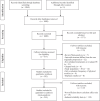Examining the reliability of the scores of self-report instruments assessing problematic exercise: A systematic review and meta-analysis
- PMID: 35482912
- PMCID: PMC9295230
- DOI: 10.1556/2006.2022.00014
Examining the reliability of the scores of self-report instruments assessing problematic exercise: A systematic review and meta-analysis
Abstract
Background and aims: Problematic exercise (PE) has mainly been assessed with self-report instruments. However, summarized evidence on the reliability of the scores derived from such instruments has yet to be provided. The present study reports a reliability generalization meta-analysis of six well-known self-report measures of PE (Commitment to Exercise Scale, Compulsive Exercise Test, Exercise Addiction Inventory, Exercise Dependence Questionnaire, Exercise Dependence Scale, and Obligatory Exercise Questionnaire).
Methods: Pooled effect sizes were computed using a random-effect model employing a restricted maximum likelihood estimation method. Univariable and multivariable meta-regressions analyses were employed for testing moderator variables.
Results: Data retrieved from 255 studies (741 independent samples, N = 254,174) identified three main groups of findings: (i) pooled alpha values that, ranging from 0.768 to 0.930 for global scores and from 0.615 to 0.907 for subscale scores, were found to be sensitive to sociodemographic and methodological characteristics; (ii) reliability induction rates of 47.58%; and (iii) the virtually non-existent testing of the assumptions required for the proper applicability of alpha. Data unavailability prevented the provision of summarized reliability estimates in terms of temporal stability.
Discussion: These findings highlight the need to improve reliability reporting of the scores of self-reported instruments of PE in primary studies. This implies providing both prior justification for the appropriateness of the index employed and reliability data for all the subpopulation of interest. The values presented could be used as a reference both for comparisons with those obtained in future primary studies and for correcting measurement-related artefacts in quantitative meta-analytic research concerning PE.
Keywords: alpha; exercise dependence; internal consistency; morbid exercise; psychometric properties.
Conflict of interest statement
The authors declare no potential conflicts of interest with respect to the research, authorship and/or publication of this article.
Figures
Similar articles
-
Theoretical conceptualisations of problematic exercise in psychometric assessment instruments: A systematic review.J Behav Addict. 2021 Apr 2;10(1):4-20. doi: 10.1556/2006.2021.00019. J Behav Addict. 2021. PMID: 33822749 Free PMC article.
-
The Bergen Facebook addiction scale: a reliability generalization meta-analysis.Front Psychol. 2025 Jan 7;15:1444039. doi: 10.3389/fpsyg.2024.1444039. eCollection 2024. Front Psychol. 2025. PMID: 39839946 Free PMC article.
-
Measurement properties of walking outcome measures for neurogenic claudication: a systematic review and meta analysis.Spine J. 2019 Aug;19(8):1378-1396. doi: 10.1016/j.spinee.2019.04.004. Epub 2019 Apr 12. Spine J. 2019. PMID: 30986579
-
A Reliability Generalization Meta-analysis of the Dimensional Obsessive-Compulsive Scale.Psicothema. 2021 Aug;33(3):481-489. doi: 10.7334/psicothema2020.455. Psicothema. 2021. PMID: 34297679
-
Reliability generalization meta-analysis of the Athens Insomnia Scale and its translations: Examining internal consistency and test-retest validity.Sleep Med. 2023 Nov;111:133-145. doi: 10.1016/j.sleep.2023.09.015. Epub 2023 Sep 17. Sleep Med. 2023. PMID: 37776584 Review.
Cited by
-
Brain default mode network mediates the association between negative perfectionism and exercise dependence.J Behav Addict. 2022 Sep 16;11(3):928-940. doi: 10.1556/2006.2022.00067. Print 2022 Sep 26. J Behav Addict. 2022. PMID: 36112490 Free PMC article.
-
Exercise addiction: A narrative overview of research issues.Dialogues Clin Neurosci. 2023 Jan 20;25(1):1-13. doi: 10.1080/19585969.2023.2164841. eCollection 2023. Dialogues Clin Neurosci. 2023. PMID: 36698618 Free PMC article. Review.
-
Body image and risk of exercise addiction in adults: A systematic review and meta-analysis.J Behav Addict. 2025 Feb 6;14(1):39-54. doi: 10.1556/2006.2024.00085. Print 2025 Mar 28. J Behav Addict. 2025. PMID: 39912824 Free PMC article.
-
The Arabic Version of Compulsive Exercise Test among Saudi Population; Translation and Validation.Sports (Basel). 2024 Jun 26;12(7):176. doi: 10.3390/sports12070176. Sports (Basel). 2024. PMID: 39058067 Free PMC article.
-
Genome-Wide Association Study of Exercise Addiction Among Elite Wrestlers.Brain Sci. 2025 Jan 22;15(2):102. doi: 10.3390/brainsci15020102. Brain Sci. 2025. PMID: 40002435 Free PMC article.
References
-
- Alcaraz-Ibáñez, M. , Aguilar-Parra, J. M. , & Álvarez-Hernández, J. F. (2018). Exercise addiction: Preliminary evidence on the role of psychological inflexibility. International Journal of Mental Health and Addiction , 16(1), 199–206. 10.1007/s11469-018-9875-y. - DOI
-
- Alcaraz-Ibáñez, M. , Paterna, A. , Sicilia, A. , & Griffiths, M. D. (2021). A systematic review and meta-analysis on the relationship between body dissatisfaction and morbid exercise behaviour. International Journal of Environmental Research and Public Health , 18, 585. 10.3390/ijerph18020585. - DOI - PMC - PubMed
-
- Alcaraz-Ibáñez, M. , Sicilia, A. , Dumitru, D. C. , Paterna, A. , & Griffiths, M. D. (2019). Examining the relationship between fitness-related self-conscious emotions, disordered eating symptoms, and morbid exercise behavior: An exploratory study. Journal of Behavioral Addictions , 8(3), 603–612. 10.1556/2006.8.2019.43. - DOI - PMC - PubMed
-
- Alchieri, J. C. , Gouveia, V. V. , de oliveira, I. C. V. , de medeiros, E. D. , Grangeiro, A. S. de M. , & da Silva, C. F. de L. S. (2015). Exercise dependence scale: Adaptação e evidências de validade e precisão. Jornal Brasileiro de Psiquiatria , 64(4), 279–287. 10.1590/0047-2085000000090. - DOI
Publication types
LinkOut - more resources
Full Text Sources


